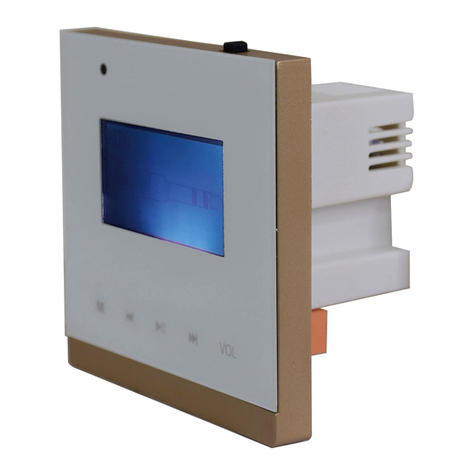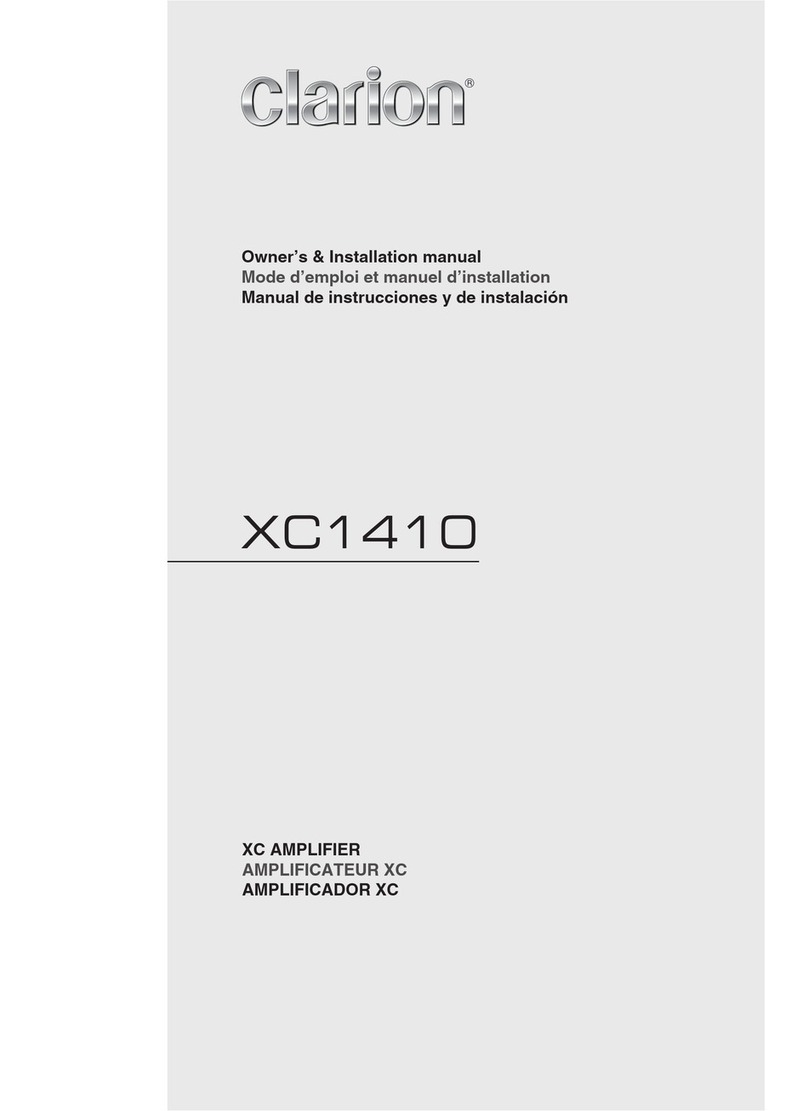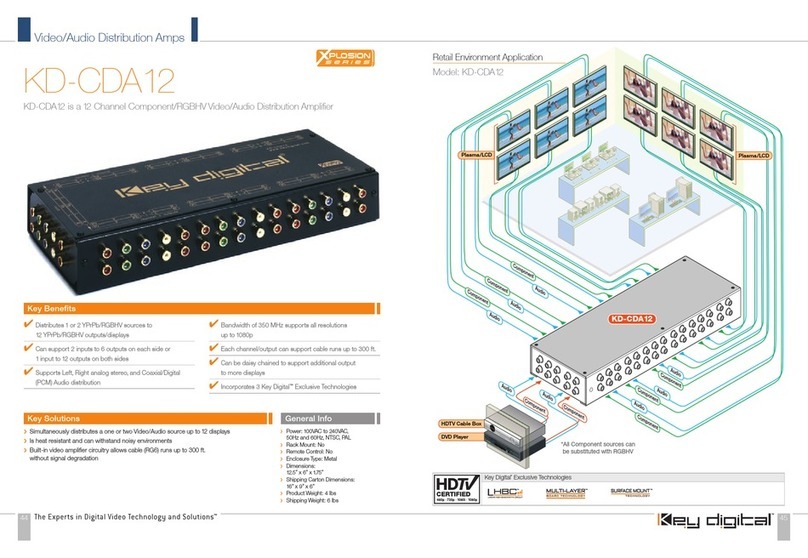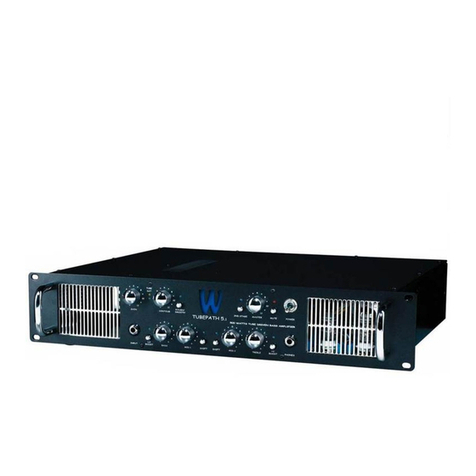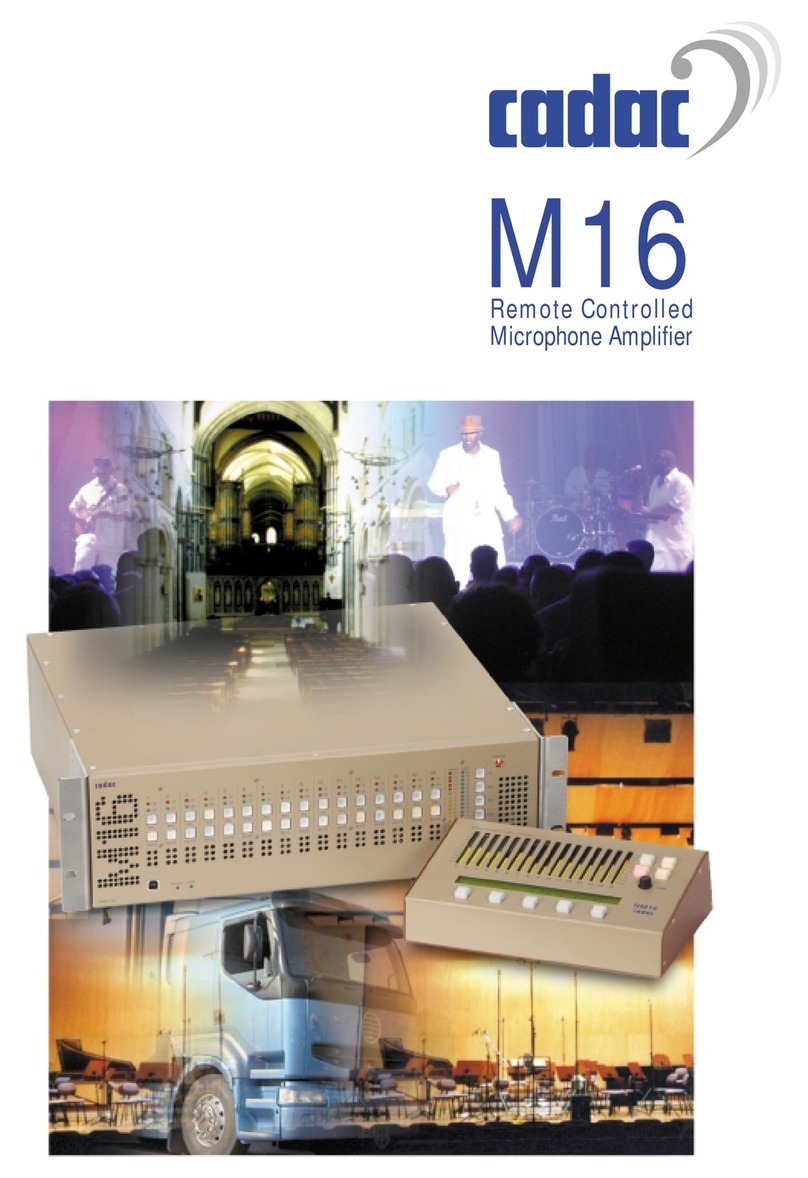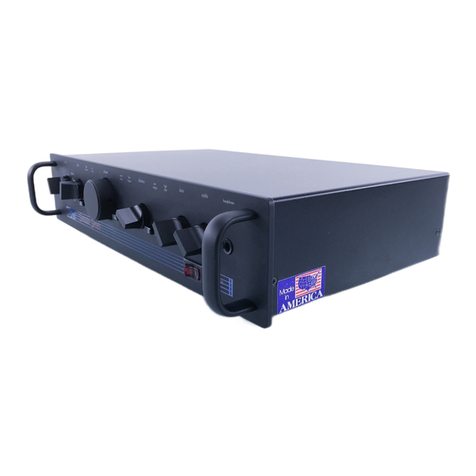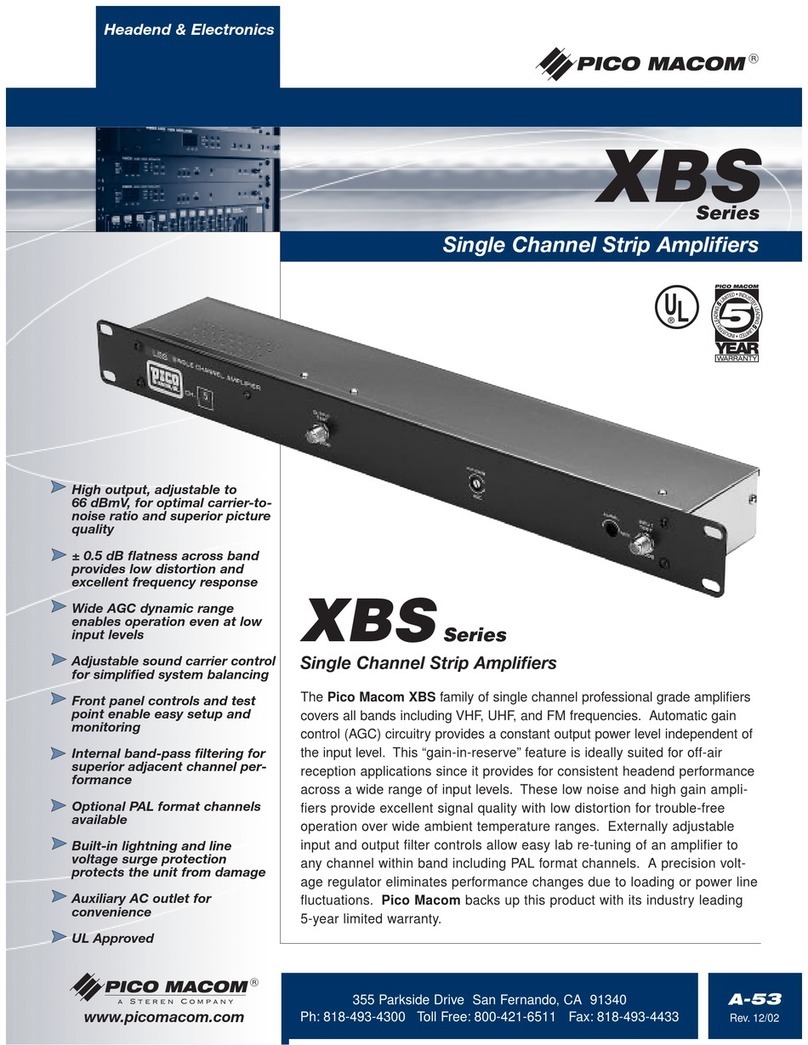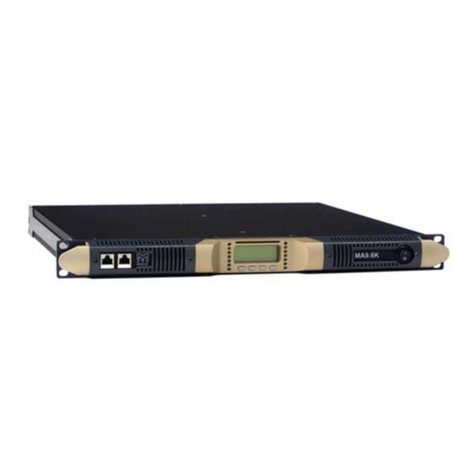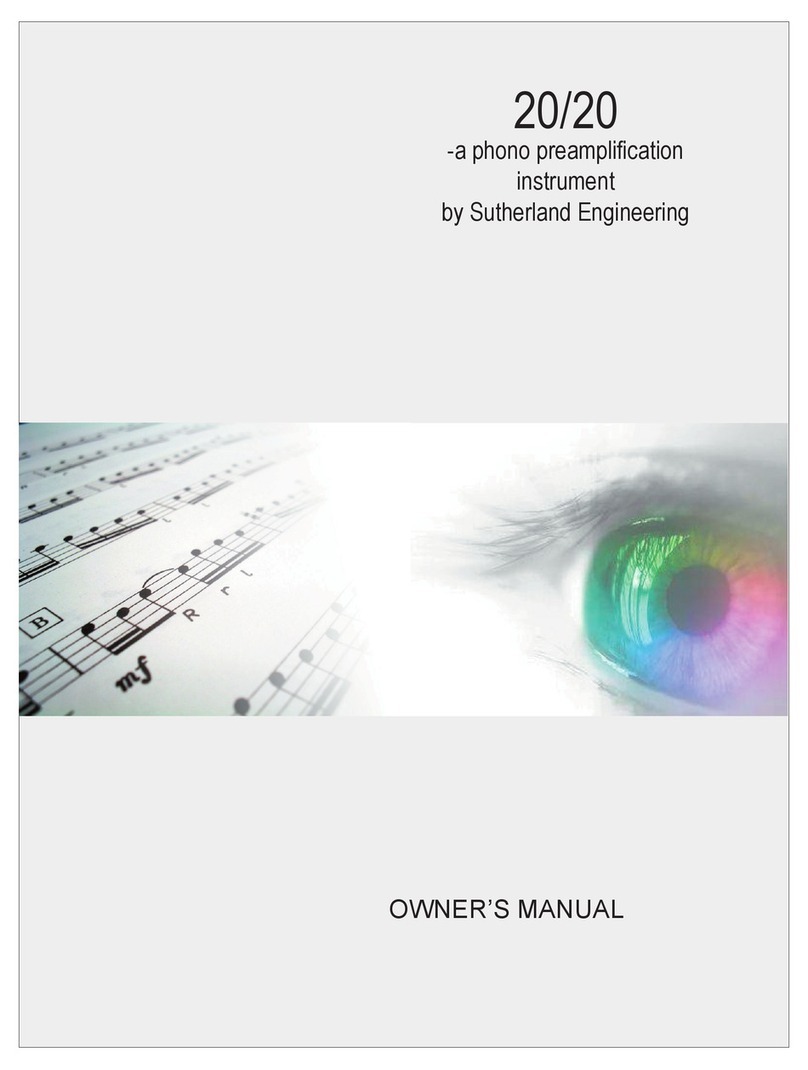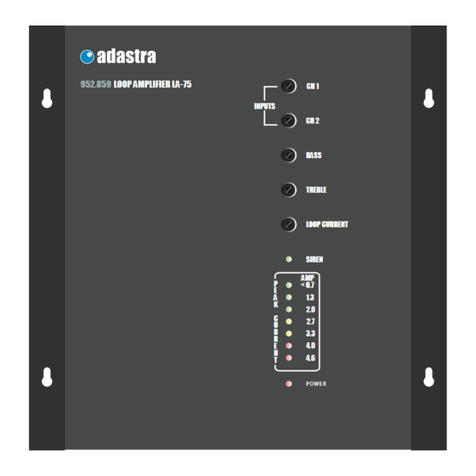Eddystone Broadcast XA150 Series Owner's manual

Print Date 01/12/09 Page 1 of 24 E2175-00MA-02
Eddystone Broadcast
----
XA150/300 Series
150W/300W
FM Amplifiers
----
Installation
and
Operation
----
Issue 2
E2175-00MA-02
February 2009
----
Eddystone Broadcast Ltd.
26, Arden Rd.
Arden Forest Industrial Estate
Alcester, Warwickshire
B49 6EP, England
Tel. 44 (0)1789 762278
Fax. 44 (0)1789 766033
www.eddystone-broadcast.com

Print Date 01/12/09 Page 2 of 24 E2175-00MA-02
Intentional blank page

Print Date 01/12/09 Page 3 of 24 E2175-00MA-02
Index
SECTION ONE : INTRODUCTION
1.1: GENERAL DESCRIPTION……………………………………………………………….…. Page 5
1.1.1 : Front Panel Module……………………………………………………………………….. Page 5
1.1.2 : Main Board………………………………………………………………………………… Page 5
1.1.3 : 150/300W Amplifier Module, Control and Power Supply…….…………..….……..… Page 6
1.1.4 : 12V Supply and Fan Control Board ……………………….……………….….……..… Page 7
1.2: VARIANTS AND OPTIONS…….…………………………………………………………… Page 7
1.3 : TECHNICAL SPECIFICATIONS…………………………………………………………… Page 8
1.3.1: Common Specifications……………………………….……………………………………Page 8
SECTION TWO : INSTALLATION
2.1 : PHYSICAL DIMENSIONS AND FITTING………………………………………………….Page 11
2.1.1 Installation Accessories……………………………………………………………………..Page 11
2.1.2 Rack Mounting………..…………………………………………………………………….. Page 11
2.2 EXTERNAL CONECTIONS………………………………………………………………….. Page 13
2.2.1 Mains Supply Connector.………………………………………………………………….. Page 13
2.2.2 RF Output Connector……………………………...……………………………………….. Page 13
2.2.3 RF Input Connector……………………………………………...………………………… Page 13
2.2.4 TCP/IP Connector………………………………………………...………………………… Page 14
2.2.5 RF Monitor Connector………………………………………………………………..…….. Page 14
2.2.6 COM Port Connector………………………………………………………………….....…. Page 14
2.2.7 Status Connector………………………………………………………………..………..… Page 14
2.2.8 Safety Interlock Connector……………………………………………………..………… Page 15
2.3 SETTING UP PROCEDURES………………………………………………………………..Page 16
2.3.1 Fuses…………………………………………………………………………………………. Page 16
2.3.2 Internal Remote Cable Link…………………………………………………………….….. Page 17
2.3.3 Output Power Level Adjustment.…………..……….………………………………….….. Page 17
2.4 SERIAL REMOTE CONTROL AND MONITORING………………………………………. Page 19
2.4.1 Introduction…………………………………………………………….……………………..Page 19
2.4.2 Control Commands and Status Monitor Requests……………………………………….Page 19
2.4.3 Reverted Status Monitor Information………………………………………………………Page 20

Print Date 01/12/09 Page 4 of 24 E2175-00MA-02
SECTION THREE : OPERATION
3.1 CONTROLS AND DISPLAYS………………………………………………………..……… Page 23
3.2 STATUS, PERFORMANCE AND LEVEL MONITORING…………….………….………. Page 24
3.2.1 MAIN Display Mode………………………………………………..………………..……… Page 24
3.2.2 MENU (of Modes) Display Mode…………………………………..………………….….. Page 24
3.2.3 SYSTEM Display Mode…………………………………………………………………….. Page 24
3.2.4 OPTIONS Display Mode………………………………………………………………….... Page 24
3.2.5 METER Display Mode……………………………………………………………………… Page 24
Bound at Rear
Front and Rear Views………………….……..………………….…... E2175-00GA
Block Diagram……………………………………………….………... E2175-00BK
Inter-Connections Circuit Diagram……………………...….………. E2175-00CT

Print Date 01/12/09 Page 5 of 24 E2175-00MA-02
SECTION ONE : INTRODUCTION
! CAUTION !
These Amplifiers operate at high RF power levels, internal supply energy levels and mains
supply current levels. They also incorporate devices containing toxic BeO. Installation, operation
and maintenance of this unit must therefore, only be carried out by suitably qualified personnel,
familiar with and fully utilising the safety procedures such equipment demands.
NO attempt at installation should be made without full reference to and compliance with SECTION
TWO : INSTALLATION.
NO attempt at internal maintenance should be made without full reference to and compliance with the
appropriate sections (fuse changing and internal option links are detailed in INSTALLATION).
1.1 : GENERAL DESCRIPTION
The XA150/300 Series of FM Amplifiers provide output powers of up to 150W (XA150) or 300W
(XA300) in the standard Band ll frequency range of 87.5-108MHz.
The Amplifiers are totally self-contained (including forced air-cooling) and can be mounted within a
standard 19 inch rack with at least 600mm depth and 2U height. All that is required is a connection to
a mains supply, to an RF source and to an antenna.
Remote control and monitoring of the Amplifier can be by serial RS232 or TCP/IP connection (internal
preset link) using asynchronous data. Basic parallel control and monitoring is also provided. On
certain variants, a mains supply on/off switch is provided on the rear panel (see section 1.2).
The Amplifier consists of a number of modules described as follows (1.1.1 – 4 inc.). Front and rear
views, block and circuit diagrams, showing these modules are bound at the rear of this manual
(E2175-00GA, E2175-00BK and E2175-00CT).
1.1.1 : Front Panel Module
The Front Panel module provides all local control and monitoring of the Amplifier functions. It also
enables this control and monitoring to be performed remotely via an RS232 or TCP/IP serial interface.
The module is microprocessor based with a back illuminated, high contrast 4 line by 20 character
display and separate ‘FAN’, ‘SYSTEM NORMAL’, ‘MUTE’ and various Amplifier (‘PA’) status red/green
indicators. A robust, sealed membrane keypad is provided with a sounder to indicate correct key entry.
A connection is provided, from the module, to RS232 and TCP/IP monitor/control ports on the rear of
the Amplifier. Selection of TCP/IP or RS232 is done by internal connections to the Main Board.
The Front Panel module also has a preset control, SET POWER, adjustable via an access hole in the
front panel, for setting the Amplifier output power level. A connector providing a sample of the final RF
output signal is provided, adjacent to the preset control, for temporary connection to external
monitoring equipment (RF MON).
Front Panel control and monitoring of the Amplifier is via a two-way serial data link to the hardware
control microprocessor on the Main Board (section 1.1.2).
1.1.2 : Main Board
The Main Board contains the main hardware control and monitor microprocessor and all connections
to other boards within the Amplifier.
The Main Board also carries all the parallel and RS232 serial control and monitoring connections to a
25 way ‘D’ socket and a 9 way ‘D’ plug respectively, on the rear panel, along with protection and
filtering for all these input/output circuits as well as the ‘open collector’ output transistors for the
parallel status output connections.

Print Date 01/12/09 Page 6 of 24 E2175-00MA-02
The microprocessor on the Main Board provides all control and monitoring of the hardware on the
board, including analogue to digital conversion of power supply levels. It also interfaces, via serial data
links, with other hardware control microprocessors on the Amplifier Control Board and on the Front
Panel module (separate dedicated bus – section 1.1.1).
A separate hardware ‘watchdog’ circuit monitors the running of the microprocessor’s program and
provides warnings (on board led, to Front Panel and to rear panel output) if the program fails to run,
and also automatically mutes the Amplifier’s output. The microprocessor also generates a mute signal
under various circumstances, this signal being directed via the safety ‘Interlock’ relay. This relay will
itself provide an over-riding mute signal if the external Interlock line is open-circuited, irrespective of
any internal Amplifier condition.
1.1.3 : 150/300W Amplifier Module, Control and Power Supply
The 150/300W Amplifier Module is fitted on a fan-cooled heatsink which runs between the front and
rear panels. To reduce ingress of dust, nearly all of the forced air is directed over the heatsink fins with
only a small ‘bleed’ of air over components mounted on the heatsink surface itself. The Module can
provide at least 150W or 300W output from approximately 2-4W RF input. The amplifier itself is an
integrated 50Ωgain block consisting of a dual RF Mosfet transistor with matching sections at its input
and output. This ‘pallet’ is mounted on an aluminium block and is easily replaced as a unit if required.
The maximum output power level is determined by the Power Supply fitted (36V for 150W, 48V for
300W). The output power level is set by the bias voltage applied to the output Mosfet by the Control
Board. A range of approximately 40W to 150W (XA150) or 40W to 300W (XA300) is provided with the
power input specified.
The Amplifier Module feeds a lowpass filter and directional coupler (both in a separate screened
section). The filter is a nine section Tchebycheff, giving a very high level of attenuation at harmonic
frequencies. The module itself also has sensors to measure heatsink temperature and output Mosfet
current. Voltages from the coupler (indicating forward and reverse power) and the sensors are fed to
the Control Board to enable accurate setting of forward output power, with a automatic reduction in
that power if reverse power, heatsink temperature or output Mosfet current becomes excessive.
A low level sample of the output power is taken from the Amplifier Module (after the separate low pass
filter section) to feed the front panel RF MON output connector.
As already described, the Control Board contains (analogue) circuitry to generate a control reference
voltage to set the bias voltage applied to the output Mosfet in the Amplifier Module. This control
voltage is initially set by the front panel SET POWER control to generate a desired power output level.
Excessive reverse power, heatsink temperature or amplifier current, above preset ‘trip’ points, then
automatically adjusts the set control voltage, gradually reducing the output power (‘fold-back’). Various
muting or external interlock conditions also over-ride the set control voltage, instantaneously reducing
the power output to a minimum.
A microprocessor on the Control Board provides all monitoring of the hardware on the board, including
analogue to digital conversion of forward/reverse power, heatsink temperature, amplifier current and
set power level. It also interfaces, via a serial data link, with the hardware control microprocessor on
the Main Board (RS485 bus – section 1.1.2). Digitised versions of all the mentioned levels and various
fault conditions (low power, power fail etc.) are sent to the Main Board and then onwards for display
on the Front Panel or remotely. A separate hardware ‘watchdog’ circuit monitors the running of the
microprocessor’s program and provides a Front Panel PA - CPU led warning if the program fails to
run, and puts the adjacent PA - FWD, REV, TEMP and CURRENT leds all off (their indications would
be invalid in this circumstance).
The Power Supply is a universal input, switched mode design, with a power rating and output voltage
dependent on the maximum output power from the Amplifier. The XA150 has a 36V, 300W supply and
the XA300 has a 48V, 600W supply. Its single output is fed to the ‘12V Supply and Fan Control Board’
(section 1.1.4).

Print Date 01/12/09 Page 7 of 24 E2175-00MA-02
1.1.4 : 12V Supply and Fan Control Board
This board contains a 20W DC-DC converter, which provides a regulated +12V dc supply from the
main 36V (XA150) or 48-50V (XA300) Power Supply. The +12V supply is further processed and
regulated to provide +5V and - 12V at point of delivery. The board also provides accurately tapped
outputs from the input 36/48V line and output 12V line to feed the A-D converter on the Main Board,
thus enabling a display of these voltage levels on the Front Panel or remotely.
This board further provides the 10A/16A fused supply to the 150/300W Amplifier Module and the fused
supply for the amplifier fan. The fan operates at 24V (XA150) or 48V (XA300) and thus there is a
factory-set link on the board, which is set according to the input supply (36V or 48-50V) to generate
the correct fan supply. The fan supply return lead is feed through a current detector circuit on this
board, which signals any low fan current state to the Main Board microprocessor.
1.2 : VARIANTS AND OPTIONS
The main variants and options (indicted by number or letter suffixes respectively) are as follows :-
E2175-01
Basic XA150 150W Amplifier
E2175-02
Basic XA300 300W Amplifier
E2175-03
Basic XA150 150W Amplifier with Mains Supply Switch
E2175-04
Basic XA300 300W Amplifier with Mains Supply Switch
No options are available for these units.

Print Date 01/12/09 Page 8 of 24 E2175-00MA-02
1.3 TECHNICAL SPECIFICATIONS
The XA150/300 Series of FM Amplifiers is designed to meet or exceed ETSI Standards :-
EN 301 489-01 : ERM/EMC for Radio Equipment, Part 1, Common Technical Requirements.
EN 301 489-11 : ERM/EMC for Radio Equipment, Part 11,Special Conditions for FM Transmitters.
EN 302 018-02 : ERM (Spectral Occupancy) for the FM Radio Broadcast Services
EN 60215:1989 : Safety Requirements for Radio Transmitting Equipment.
1.3.1: Common Specifications
RF Interface Ports 50Ωnominal, TNC connector for input, N Type for output.
Carrier Frequency 87.5-108MHz
Input Drive Power RF Input from Exciter/Drive, 2-4W typical, 8W maximum
Output Power With any load with a return loss >14dB (1.5:1 VSWR) any angle.
XA150 Adjustable over range of at least 40W to 150W
XA300 Adjustable over range of at least 40W to 300W
Variation : Not more than ±0.5dB under all specified operating conditions
Output Power
Shutdown
Output power is automatically reduced or shutdown to ensure that any load
producing reverse power greater than approximately 30W including open and
short circuits, does not cause any damage to the Amplifier. Excessive
heatsink temperature (greater then +85 deg.C) or output amplifier current
also automatically reduces or shutdowns the output power.
Reverse
Intermodulation
Reverse intermodulation products will be better than or equal to –10dB,
relative to the interfering incident signal, this being offset over the range
±300kHz to ±20MHz (but remaining within 87.5MHz to 108MHz).
Spurious and
Harmonic
Emissions
In the range 9kHz to 1000MHz : -
Better than or equal to –75dBc - typically better than –85dBc
In the range 87.5MHz to 137MHz : -
Better than or equal to –85dBc at greater than 500kHz removed from carrier.
Measured in a 10kHz bandwidth, with and relative to, an unmodulated carrier.
Adjacent Channel
Spurious Emissions
Better than or equal to –20dBc at ±125kHz removed from carrier
Better than or equal to –40dBc at ±150kHz removed from carrier.
Better than or equal to –60dBc at ±175kHz removed from carrier
Better than or equal to –80dBc at ±200kHz removed from carrier.
Better than or equal to –85dBc at ±300kHz to ±500kHz removed from carrier.
Measured in a 1kHz bandwidth, with a ±75kHz deviation, 400Hz mono signal.
Spurious levels relative to peak signal carrier/sidebands (i.e. within a
spectrum mask defined by above limits).
Status Indications Four line by 20 character back-lit LCD display with selectable screens
showing forward and reverse power; individual system normal status
components; comprehensive bargraph and digital readout metering of
analogue levels.
Red/green/off led indicators for fan operation, system normal status and mute
status.
Red/green pass/fail led indicators of Amplifier Module output forward and
reverse power, heatsink temperature, dc supply current and CPU status.

Print Date 01/12/09 Page 9 of 24 E2175-00MA-02
Local Control Eight key sealed membrane keypad including : -
main and mode screen dedicated keys, two cursor keys and four soft keys.
Remote Control
and Monitoring
RS232 or TCP/IP (preset internal link setting) using 2400, 4800, 9600 or
19200 Baud asynchronous data (1 start, 8 data, 2 stop, no parity) rate
selectable from front panel. All local control and monitoring is duplicated over
the serial link. RS232 on nine way ’D’ plug, TCP/IP on RJ45 socket.
Basic parallel control/monitoring including analogue output voltage levels
indicating forward and reverse output power (on 25 way ‘D’ socket). RF
monitoring BNC output on front panel.
Safety Interlock Safety interlock on separate 2 way screw terminal connector.
Note that this duplicates a pair of inputs on the Remote Control 25 way ‘D’
socket detailed above.
Environmental Ambient Temperature (operating) : -5 to +50 deg.C
Ambient Temperature (storage) : -20 to +70 deg.C
Relative Humidity (operating) : Less than or equal to 95%, non condensing
with the Amplifier at a higher temperature than the ambient.
Altitude (operating) : Up to 3000 metres a.s.l.
Mechanical Width : 483mm (19 in.)
Height : 88mm (2U)
Depth : 520mm
Weight : Approx. 15kg.
Note depth is intrusion into rack including cabling at the rear.
Power Supply Single phase input on 10A IEC connector: -
XA150 : 100-260VAC (47-63Hz)
3A at 100V to 1.2A at 260V (at 150W RF output)
Power factor meets EN61000-3-2
Peak inrush current 14A - 28A at 100V - 260VAC input
XA300 : 100-260VAC (47-63Hz)
6A at 100V to 2.4A at 260V (at 300W RF output)
Power factor meets EN61000-3-2
Peak inrush current 14A - 28A at 100V - 260VAC input

Print Date 01/12/09 Page 10 of 24 E2175-00MA-02
Intentional blank page

Print Date 01/12/09 Page 11 of 24 E2175-00MA-02
SECTION TWO : INSTALLATION
! CAUTION !
These Amplifiers operate at high RF power levels, internal supply energy levels and mains
supply current levels. They also incorporate devices containing toxic BeO. Before commencing
installation, it is recommended that the complete INSTALLATION section is read and understood. The
instructions should then be strictly followed, by suitably qualified personnel, otherwise sub-
standard or even dangerous operation may result.
2.1 : PHYSICAL DIMENSIONS AND FITTING
2.1.1 Installation Accessories
Various installation accessories may be supplied as required. A list of these (including spare fuses) is
given below. Actual requirements depend on the configuration of the equipment supplied and whether
or not leads are supplied ready made etc. Note that extra, unlisted parts may be required for
connections to any Amplifier that is supplied (see manuals supplied with them).
Typical
Quantity
Description Function
1 10A (C13) IEC mains connector. For connection to lead from mains supply
distribution point.
Length as
req’d
3 core,1.0mm
2
per core, insulated cable
(EPR insulated, HOFR sheathed) )
or
3 core,1.5mm
2
per core, insulated cable
(PVC insulated and sheathed)
Mains supply lead for operation in up to 50
deg.C ambients.
1 10A ‘C’ rated 2 pole miniature circuit
breaker (MCB).
Fitted at mains supply distribution point to
protect supply lead and mains input
components in the Amplifier.
1 N type RF coaxial free plug
plus low loss RF coaxial cable as req’d
(rated in excess of Amplifier output
power at maximum ambient
temperature)
For connection to RF output
1 TNC type 50Ωcoaxial free plug
plus RF coaxial cable as req’d
For connection to RF input
1 2 Way, 5.08mm pitch screw terminal
block (c/w wire shorting link).
(e.g. Weidmuller BL5.08/2)
External safety interlock connector (wire
shorting link is removed when connector is
wired to external safety circuits)
1 9 Way D plug c/w cover. For connection to leads from serial RS232
control/monitor ancillary equipment.
1 25 Way D plug c/w cover. For connection to leads from parallel
control/monitor ancillary equipment.
Length as
req’d
Multi-core screened cable (number of
cores as required).
Control/monitor leads.
Length as
req’d
Heavy gauge grounding wire/strap. For safety earth lead.
4 Screws c/w plastic cup washers and
rack caged nuts.
For fixing unit into19 inch rack.
2 Side support ‘L’ brackets c/w fixing
screws and washers.
For extra support to carry the Amplifier’s
weight in the rack.
1 6.3A (T) HBC 5x20mm Fuse For protection of ac supply input circuitry
1
(XA150
only)
10A (T) HBC 5x32mm (¼ x1¼ in) Fuses
For protection of internal dc supply to
output amplifier
1
(XA300
only)
16A (T) HBC 5x32mm (¼ x1¼ in) Fuses For protection of internal dc supply to
output amplifier

Print Date 01/12/09 Page 12 of 24 E2175-00MA-02
2.1.2 Rack Mounting
If the Amplifier is not supplied ready mounted in a 19 inch rack, this will be required to be done at time
of installation.
The 19 inch rack should ideally be of standard 600mm depth and requires at least 2U for the
XA150/300. Additional height will be required if a second Amplifier is to be fitted into the same rack.
Additional bottom support ‘L’ brackets may also be required at each side, below the Amplifier, to help
carry its weight. The Amplifier is then fixed to the front of the racking using four screws, plastic cup
washers and caged nuts.

Print Date 01/12/09 Page 13 of 24 E2175-00MA-02
2.2 EXTERNAL CONECTIONS
All permanent external connections are made at the rear of the unit in accordance with system
requirements. The connections required are made as described in the following sub sections.
2.2.1 Mains Supply Connector
This is a standard IEC connector PL02, at the right rear of the unit, intended for connection to a single
phase (plus protective earth) supply. The input is protected by a 20mm 6.3A(T) HBC fuse fitted in a
carrier in PL02.
! CAUTION ! – On certain variants, a rear panel on/off switch is provided in-line with this
connector. Note that this switch interrupts the Neutral supply line only (see section 1.2).
For the XA150, the supply is in the range 100-260VAC (47-63Hz) with no setting required. The
maximum current drawn from the supply is in the order of 3A at 100V to 1.2A at 260V (at 150W RF
output).
For the XA300, the supply is also in the range 100-260VAC (47-63Hz) with no setting required. The
maximum current drawn from the supply is in the order of 6A at 100V to 2.4A at 260V (at 300W RF
output).
The mains supply lead to the Amplifier must use at least 10A rated three core (P+N+protective
earth) insulated cable. A double pole 10A (C rated) MCB must be provided at the supply
distribution board (preferred) or a 10A HBC fuse in the associated plug at the supply outlet, to
protect this lead. Also, since the supply input circuitry contains a filter, which passes current to the
Amplifier chassis, the chassis must be connected to a safety ground via the earthing bolt provided
adjacent to the mains supply input connector.
The supply lead terminates in a 10A (C13) IEC free socket at the Amplifier end, which is wired as
follows :-
L or Brown Line
N or Blue Neutral
⊥or
Green/Yellow
Protective
Earth
Care MUST be taken to connect these leads to the supply as detailed in the above table. If a
lead with different coloured wires is used, further advice MUST be taken.
Also ensure whilst making any connections to the mains supply, that the Amplifier’s rear panel
interlock circuit at PL07, pins 1 and 2, is open-circuit (i.e. Amplifier muted).
2.2.2 RF Output Connector
! CAUTION !
When operating, high RF Voltages are present on this connector. Always ensure when making
connections here, or working on any load connected, that the Amplifier’s mains supply is
either disconnected or switched to ‘off’ at the distribution board (preferably being locked in
that position).
This is an N Type coaxial socket SK08 at the rear of the unit. Care must be taken to use adequately
rated (at maximum ambient temperature) low loss cable for the lead to the antenna, amplifier or load.
2.2.3 RF Input Connector
This is a 50ΩTNC coaxial socket SK06 at the rear of the unit. The input signal is typically 2-4W and
must not exceed 8W.

Print Date 01/12/09 Page 14 of 24 E2175-00MA-02
2.2.4 TCP/IP Connector
This is an RJ45 connector SK03 fitted at the rear of the unit. This enables all the control and
monitoring detailed in Section 2.4 to be performed using TCP/IP (Transmission Control/Internet
Protocol).
This arrangement requires the unit to be assigned a unique Internet Protocol address. When first
connected to the network via its RJ-45 connector, the Amplifier’s TCP/IP adapter will attempt to
acquire an IP address automatically (it’s quite common to have networks configured to use ‘DHCP’,
which provides these addresses on demand). The address to which a device has been assigned can
then be determined and, if required, be overridden with a desired fixed value, using Eddystone
supplied software.
Note that an internal lead connection determines if serial control and monitoring is via this RJ45
connector or via the rear panel (RS232) COM Port connector PL04 (see 2.2.12). For TCP/IP control,
the 3 pin screened lead from the Front Panel board connector (6)CON05 must be plugged into the
Main Board connector (5)CON04.
2.2.5 RF Monitor Connector
This is a 50ΩBNC coaxial socket SK01 on the left hand side of the Amplifier front panel. This provides
an harmonically filtered sample of the Amplifier’s forward output power at a level, into 50Ω, of
approximately 10mW at maximum power output. This connector is for test purpose only with the test
equipment and lead being disconnected when not in use. NOTE that the levels of any harmonics
present are not necessarily equal to those at the antenna.
2.2.6 COM Port Connector
This is a 9 Way D plug PL04 on the rear panel. This enables all the control and monitoring, detailed in
Section 2.4, to be performed using a personal computer with its (RS232) COM port connected to this
port. Multi-core screened cable, not exceeding 30 metres in length, should be used for the
interconnecting lead. The lead terminates in a 9 Way free D socket at the Amplifier end which is wired
as follows :-
Pin 1 Not connected
Pin 2 Received Data (to Amplifier)
Pin 3 Transmit Data (from Amplifier)
Pin 4 Not Connected
Pin 5 Ground
Pin 6 Not Connected
Pin 7 Not Connected
Pin 8 Not Connected
Pin 9 Not Connected
Note that the assigned pin numbers and their functions are for a standard 9 pin plug on ‘Data Terminal
Equipment’ (DTE) such as computers. Standard crossover or ‘null modem’ leads must thus be used
for connection to a personal computer or PC. The length of the interconnecting lead may be extended
by use of compatible RS422/485 or fibre-optic line drivers.
Note that an internal lead connection determines if serial control and monitoring is via this RS232
connector or via the rear panel TCP/IP connector SK04 (see 2.2.7). For RS232 control, the 3 pin
screened lead from the Front Panel board connector (6)CON05 must be plugged into the Main Board
connector (5)CON05.
2.2.7 Status Connector
This is a 25 Way D socket SK05 at the rear of the unit. This is used to enable basic external
monitoring and control. Multi-core screened cable, not exceeding 3 metres in length, should be used
for the interconnecting lead.

Print Date 01/12/09 Page 15 of 24 E2175-00MA-02
The lead terminates in a 25 Way free D plug at the Amplifier end which is wired as follows :-
Pins
1 -6
Not Used 1-6
Pin 7 Forward Power Low (approx. –2dB rel. set o/p - pulled to ground when good)
Pin 8 Forward Power Fail (approx. –12dB rel. max o/p - pulled to ground when good)
Pin 9 Reverse Power High (approx. 30W - pulled to ground when good)
Pin 10 Not Used 7
Pin 11 Heatsink Temperature status output (pulled to ground when good i.e.<85deg.C)
Pin 12 Not Used 8
Pin 13 System Normal status output (pulled to ground when good)
Pin 14 Chassis Ground
Pin 15 Chassis Ground
Pin 16 Forward power analogue monitor voltage output (0-5V into >1kΩ)
approx.2V at 150W to 3V at 300W
Pin 17 Reverse power analogue monitor voltage output (0-5V into >1kΩ)
approx. 0.7V at 15W to 1V at 30W
Pin 18 Chassis Ground
Pin 19 Chassis Ground
Pin 20 Chassis Ground
Pin 21 Safety Interlock input (ground to de-mute) in parallel with PL07
Pin 22 Mute RF input (ground to mute) – for control not safety purposes
Pin 23 +12v dc fused supply output (150mA maximum)
Pin 24 CPU status output (pulled to ground when Main Board CPU good)
Pin 25 Fan status output (pulled to ground when good)
The Mute RF input pin 22 (ground to mute) is read by software (with a short delay) and thus is not so
direct, being intended for control purposes only and not as part of a safety interlock system.
Any of the ‘pulled to ground when good’ status outputs required to be used, must be returned to a
supply of no greater than 25V and must be limited to drawing no more than 50mA each by additional
external resistance (100Ωis provided internally).
All of the ‘ground to operate’ inputs (except pin 21, the safety interlock) are internally pulled up to +5V
via 12kΩand must be fed from a voltage free source of less than 1kΩto ground to operate (open
circuit for a high non-operating state). These inputs are protected against constant application of up to
±25V dc directly applied.
2.2.8 Safety Interlock Connector
This is a two pin connector PL07 on the rear panel wired in parallel with pins 21/20 of connector SK05
(see section 2.2.7). Either pair, but not both, may be used as described below.
Pin 1 Safety Interlock input (ground to de-mute) - same as pin 21 of PL07
Pin 2 Chassis Ground – same as pin 20 of PL07
For the safety interlock, a circuit has to be made between pins 1 and 2 (or 20 and 21 of PL07) which
open-circuits to mute the Amplifier or short-circuits to de-mute. If there are no external safety interlock
switches, a short direct link is made, this being the state in which any connector is normally supplied. If
connections need to be made to external safety switches, this link is removed and the switches are
wired in a series loop to the connector so that if any switch opens, the link is broken. Note that the
safety interlock provides the most direct, and thus safest, muting of output power.
! CAUTION !
For the safety interlocks to work correctly, the external switches and link wiring must ‘float’
(i.e. must not be grounded at any point, apart from at the Amplifier itself). The total loop
resistance should not exceed approximately 10Ω. The external wiring may also be ferrite loaded for
emc requirements.

Print Date 01/12/09 Page 16 of 24 E2175-00MA-02
2.3 SETTING UP PROCEDURES
2.3.1 Fuses
If any problems occur after the Amplifier has been installed and switched on, fuses may need to be
checked and possibly replaced. However, a blown or high impedance fuse would generally indicate
the presence of a fault, which would need correcting.
The type, function and access to fuses is as follows :
Type Function Access
6.3A (T) HBC
5x20mm Fuse
For protection of ac supply input
circuitry.
If this fuse blows, all Amplifier
operation ceases
FS1 at the right rear of the unit (being
part of mains input socket PL02).
! CAUTION ! Ensure that the mains
supply is either disconnected or is
switched to ‘off’ at the distribution
board (preferably being locked in that
position).
0.21A Hold
SMD 030-2
Resettable Fuse
For protection of the +12V dc
output on the rear panel Status
connector SK05.
If this fuse goes high impedance,
any external equipment powered off
this supply will cease operation.
Access to this fuse is not normally
required (smd fuse is fitted to the Main
Board, on which SK05 is located).
This fuse will automatically reset if the
externally supplied equipment is
momentarily disconnected or if the
mains supply to the Amplifier is
interrupted.
0.21A Hold
SMD 030-2
Resettable Fuse
(XA150)
or
0.35A Hold
SMD 050-2
Resettable Fuse
(XA300)
For protection of the rear panel fan
and its supply leads.
If this fuse goes high impedance,
this fan will cease operation. The
Fan and System Normal leds will
go red (check System mode display
to confirm fault). After a period, the
Output Amplifier temperature will
increase and the output power
eventually turn down (with an over-
temperature indication).
Access to this fuse is not normally
required. This smd fuse is fitted on the
narrow printed circuit board (Fan Control
Board) immediately in front of the power
supply unit (and behind the front panel).
This fuse will automatically reset if the
Fan is momentarily disconnected or if
the mains supply to the Amplifier is
interrupted.
1.4A Hold
SMD 200-2
Resettable Fuse
For protection of all circuitry
supplied by the internal +12V dc
supply.
If this fuse goes high impedance,
virtually all Amplifier operation
ceases (apart from the fan).
Access to this fuse is not normally
required. This smd fuse is fitted on the
narrow printed circuit board (Fan Control
Board) immediately in front of the power
supply unit (and behind the front panel).
This fuse will automatically reset if the
mains supply to the Amplifier is
interrupted.

Print Date 01/12/09 Page 17 of 24 E2175-00MA-02
Type Function Access
10A/16A (T) HBC
5x32mm Fuse
10A for XA150
16A for XA300
For protection of the internal dc
supply lead to the high current
circuitry within the output amplifier.
If this fuse blows, the output power
will reduce to zero.
Remove top dust cover. Fuse is fitted in
clips on the narrow printed circuit board
(Fan Control Board) immediately in front
of the power supply unit (and behind the
front panel).
! CAUTION ! Ensure that the mains
supply is either disconnected or is
switched to ‘off’ at the distribution
board (preferably being locked in that
position).
2.3.2 Internal Remote Cable Link
The cable link is as follows :-
Remote Control Option Link Front Panel Connector (6)CON05 to :-
Serial RS232 via COM Port PL11 Main Board Connector (5)CON05
TCP/IP via RJ45 Connector SK04 Main Board Connector (5)CON04
2.3.3 Output Power Level Adjustment
If the Amplifier is not supplied with preset output power level, its front panel SET POWER control will
need to be set. If being used as a drive for another amplifier, the manual for the amplifier must be
consulted for information on the level of drive output power required and care must be taken that the
maximum drive level for that amplifier is not exceeded.
The procedure is as follows :
1) Ensure the Amplifier has been installed as detailed in sections 2.1 and 2.2 and the internal
remote cable link is set as in 2.3.2 (as required).
2) Break the rear panel Interlock connection between pins 1 and 2 of PL07 (and any connection
between pin 21 and ground on SK07) and ensure all external RF sources are switched off.
3) Apply power to the Amplifier (i.e. ensure the supply distribution 10A MCB, if fitted, is on and
the supply lead is connected). If fitted, ensure that the rear panel supply switch is in the ‘on’
position (‘I’).
4) Ensure that the power on audio tone sounds, the LCD display illuminates (briefly displaying
Amplifier type information) and all LED displays are on red, green or amber. If not, follow fuse
checking procedure as detailed in section 2.3.1 (fault finding may be required if this occurs).
5) Check that the LCD display settles, showing the ‘MAIN’ screen, which gives forward and
reverse output powers (both near zero because of interlock).
6) Set the Amplifier’s front panel SET POWER twenty-two turn control to fully clockwise (i.e.
maximum power setting).
7) Reconnect the rear panel Interlock connection between pins 1 and 2 of PL07.
8) Introduce the Exciter/Drive source at the required frequency (in the range 87.5-108MHz) and
at a low level (less than about 0.5W) at SK06.

Print Date 01/12/09 Page 18 of 24 E2175-00MA-02
9) Slowly increase the source power level until 150W (XA150) or 300W (XA300) is obtained. To
ensure complete accuracy, an external calibrated meter should be used to measure this
output power. On the XA300 only, increase the input level by a further 1dB (approximately
20%). In no case however, must the input power exceed 8W.
10) With the source power level set as described, turn the front panel SET POWER control anti-
clockwise until the measured power falls back to the output power required (300W maximum
on the XA300).
11) Check the forward output power displayed on the front panel LCD display. This reading will
not be as accurate as the external calibrated meter but should be within about ±0.25dB
(approx.10-15W). The reverse power displayed should be very low, not more than about 5-
15W, depending on the load presented to the Amplifier and its set output power.
The Amplifier will now be ready for operation.
The Front Panel RF MON output can be used to check the close-in spectrum of the Amplifier output
signal, noting that any harmonic levels shown will not necessarily be the same as those present at the
Amplifier output. Any test equipment should not however normally be left connected to this output.

Print Date 01/12/09 Page 19 of 24 E2175-00MA-02
2.4 SERIAL REMOTE CONTROL AND MONITORING
2.4.1 Introduction
Serial control via the rear panel COM PORT connector (section 2.2.6) uses asynchronous data (1
start, 8 data, 1 stop bit, no parity) at 2400, 4800, 9600 or 19200 Baud. Control commands and status
monitor requests are detailed in section 2.4.2. The content of status monitor information reverted from
the Amplifier is detailed in section 2.4.3. The same functions are also enabled using TCP/IP via a rear
panel RJ45 connector (section 2.2.4). Selection of COM port or RJ45 connector is made using internal
link leads.
The individual data bytes are defined in ASCII form, to enable basic control and monitoring using a PC
running a terminal program. However, a PC program with a dedicated textual and/or graphical user
interface is required for proper implementation of a remote control and monitoring system. Eddystone
Broadcast should be contacted for further information regarding such programs and hardware
implementations using the RS232 and TCP/IP ports directly or via USB or TCP/IP adaptors.
2.4.2 Control Commands and Status Monitor Requests
All command and status monitor requests are initiated by the remote control unit (PC) – the Amplifier
never outputs any serial data via the COM PORT or TCP/IP connector unless requested to by that
unit.
The remote control unit always sends a sequence of three bytes, waiting for each byte to be ‘echoed’
correctly before the next one is sent (which must be within 500mS of the previous one). A wait of
500mS is also recommended before the sequence is timed out and aborted. A new sequence of three
bytes then can be attempted. Note that an echo will not be returned when an invalid sequence is
detected by the Amplifier.
The three bytes are :-
First byte ‘Handshake’ (always ASCII #) – indicates start of sequence
Second byte ‘Command’ – indicates form of control or status monitoring
Third byte ‘Status Requests’ (after ASCII ? Command)
- gives details of status monitoring required
Details of the Handshake, Command, Status Request and Control bytes are given in the following two
tables. Typical examples of controller generated sequences are as follows :-
# ? 0 Request to revert output power and Amplifier type
# ? W Request to revert temperature and current
Handshake
(first byte sent from controller)
Title Function Hex ASCII
Async_Hshake Remote input handshake 23 #
Remote Input Commands
(second byte sent from controller)
Title Function Hex ASCII
Query_Status Status query (request to revert) 3F ?

Print Date 01/12/09 Page 20 of 24 E2175-00MA-02
2.4.3 Reverted Status Monitor Information
The status of the Amplifier is reverted in response to the ? command (see section 2.4.2). After the
third byte is echoed back to the remote control unit, a further fifteen bytes are sent immediately from
the Amplifier, with no delays between individual bytes (each 1 start, 8 data, 1stop, no parity).
The first fourteen of the fifteen bytes contains the specific status information requested. The last byte
is an exclusive OR checksum of those fourteen bytes. This checksum can be used by the remote
control unit to check that the information has not become corrupted.
The meanings of the various bytes in the information string are defined in the table below.
Reverted Status Information
(meanings of bytes reverted in response to ?command)
Title Meaning Hex ASCII
Norm Status normal 4E N
N_Norm Status not normal 4F O
Stat_Low Status low 4C L
Stat_High Status high 48 H
Fail Status fail 46 F
Off Status off 52 R
On Status on 51 Q
Mute Status muted 4D M
Start Status start 53 S
De_Sel Status de-selected 44 D
Int_Sel Status internally selected 49 I
Ext_Sel Status externally selected 56 V
N_Known Not known 58 X
None None 57 W
N_Applic Not applicable 5A Z
Direct Display Numerical values 30-39 0-9
Direct Display Sign 2B 2D + -
Direct Display Decimal point 2E .
Direct Display Blank 00 NUL
Direct Display Less than 3C <
Most meanings are general. A string of fourteen system status information bytes would typically
contain several ‘N’s, each one indicating that a particular status (forward power, reverse power etc.) is
‘Normal’.
Direct display bytes give an immediate numerical display of power, current and temperature etc., even
when using a basic terminal program.
If the Amplifier contains no known good information about a particular status, the ‘X’ byte is reverted.
This occurs if the Amplifier is unable to interrogate individual modules within the unit and thus cannot
determine their status. The ‘Revert Output Status Request’ (ASCII 0) returns the Amplifier type and
can be used by the Remote Control Unit to determine the power rating of the Amplifier being
interrogated.
This manual suits for next models
1
Table of contents
